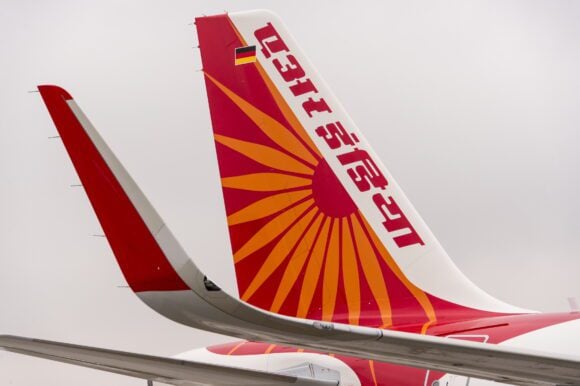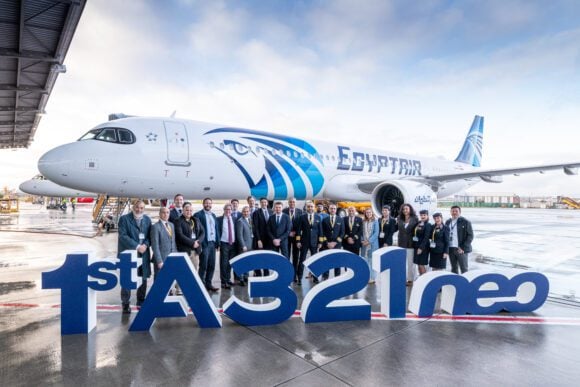
MAX family 1 of 1 scaled
UPDATE – Boeing reiterates its delivery targets of 400 to 450 737s and MAX aircraft for this year, despite the latest quality issue with fittings of the vertical tail fin. Inspections and rework on aircraft in production and inventory “will impact the timing of deliveries over the next several months; however, we remain confident in the operational and financial goals we set for this year, as well as for the longer term,” President and CEO David Calhoun said in the earnings release today. Tailfin issues won’t affect total Boeing 737 and MAX deliveries.
The tailfin issue came to light only recently after Tier-1 supplier Spirit AeroSystems advised Boeing of the problem. Two of the eight tailfin fittings on some 737s and MAX aircraft that have been produced since July do have the flaw on all versions except the MAX 9 and -10. Boeing confirmed again today that “this is not an immediate safety of flight issue and the in-service fleet can continue operating safely.”
During today’s earnings call, Chief Financial Officer Brian West said that of the 225 MAX in inventory, 75 percent (some 170 aircraft) will require the fuselage/tailfin rework. A non-material financial charge of $188 million has been made in Q1 to cover the costs of this rework, which will affect deliveries in April and Q2. Calhoun said last week during Boeing’s annual general meeting that he expected the issue to affect 45-50 deliveries of MAX aircraft in the coming months. United Airlines confirmed that at least six MAX 8 deliveries have shifted from Q2 to Q3, but potentially more aircraft could be affected.
Impossible to spot visibly
Calhoun explained that the tailfin issue, which has been traced back by Spirit AeroSystems on aircraft produced in 2019, was very difficult to spot. “This particular defect is impossible to visibly assess once the process to do it (fit the tailfin) is complete. The process was not standard, and importantly, there was a sealing that was applied on top of the fitting that made it impossible to notice any cracks. (…) I celebrate the fact that an employee (at Spirit) witnessed the procedure and raised his hand and said: ‘That doesn’t look right.’ That is the only way we would ultimately find out about it. That’s why I am encouraging everybody in our supply chain to raise their hand if they see something of that sort.”
Boeing has identified the procedures that are needed for the rework. “We know barrel by barrel what needs to be done. If the unit is not too far in our production cycle, it is a matter of days. If you have to lift the vertical fin off the airplane it obviously becomes more complicated and takes more time,” said West. This is expected to take weeks. Spirit AeroSystems has also traced the root cause of the error and will start delivering ‘clean’ fuselages to Boeing imminently. The issue has not changed the relations between Boeing and Spirit, which it needs for the ramp-up of production. In fact, Boeing not only supports Spirit with resources to solve the issue but will also assist in cash to help the company overcome the current period.
“We will stay present with Spirit. We are in their factories, we are talking to their people. There are a few ways you can look at the issue: it was difficult to find, but an employee raised his hand and noticed a bad procedure and everybody jumped on it. Within a week, we had this resolved with the FAA, we had a clear picture of the airplanes that were affected and we all work on the rework. We are going to work together constructively with Spirit, I have confidence that Tom (Gentile, CEO) and the team,” said Calhoun.
The MAX 9 and -10 are not affected by the tailfin issue, says Boeing. (Richard Schuurman)
Ramping up MAX production
Production of the 737/MAX has fluctuated in recent months as supply chain issues continue, but West is confident that the monthly output will reach thirty aircraft on average over HY1. This will likely result in an increase in the number of aircraft in inventory as time is needed for the rework, but the inventory should be cleared by the end of 2024.
Boeing confirmed previous reports that the production rate for the 737 P-8A and MAX variants will increase to 38 per month “later this year”, with Brian West mentioning “around forty per month” for HY2, “with sequential improvements in the back half.” The rate should go to 50 aircraft in 2025-2026. Despite the tailfin issue, Boeing is sticking to its master production plan for the rate increase and contemplating inventory building into its forward look. Even with these higher rates, production is now pretty much sold out through the end of the decade.
And it’s not just the MAX that gets higher rates, the airframer also announced that production of the 787 is now gradually ramping up. After some two years at very low rates during the Dreamliner production quality issue period, the 787 is now built at three aircraft per month and will go to five per month later this year. The airframer reiterates that total production for the year should get to 70-80 Dreamliners. A further increase to rate 10 per month is still planned for 2025-2026.
Since the closure of the Everett facility, the 787 is only produced in North Charleston. This factory never produced more than seven aircraft per month in the past. Asked if the plant is ready to accommodate the higher rate of ten per month at higher margins, David Calhoun said that investments will be only limited. “With respect to investments, this has a lot less to do with physical equipment but more with how we route things through the factory. Today, our factory is very much constrained because of the joint verification work on the 787 that takes up a lot of space. We have a team that is constantly working on the new routings and we are confident that we can get to ten.” In 2025-2026, margins will be higher than they were in 2018.
By the end of March, Boeing had 95 Dreamliners in inventory. It booked $379 million in abnormal costs in the program, in line with the total estimate of $2.8 billion. Deferred production costs for the 787 stood at $12.416 billion by the end of Q1, down some $200 million in Q4.
On the 777X, Brian West had little to say, with the program timeline toward certification in 2025 and total abnormal costs of $1.5 billion in line with expectations. Q1 included $126 million in abnormal costs.
First quarter results
The first quarter produced a $-425 million consolidated net loss compared to $-1.242 billion last year. Revenues increased to $17.921 billion from $13.991 billion. The operating loss was $-149 million versus $-1.162 billion, resulting in an operating margin of -0.8 percent versus -8.3 percent. The operating cash flow was $-318 million (2022: $-3.216 billion), with a free cash flow of $-716 million ($-3.565 billion). This follows on Q4 with a positive free cash flow of $3.131 billion, but Q1 saw fewer widebody deliveries and was impacted by seasonality. Boeing ended the quarter with $10.8 billion in cash and $4.0 billion in marketable securities. Another $12 billion is available with an undrawn revolving credit facility. Net debt was $1.7 billion to $55.4 billion.
Boeing Commercial Airplanes (BCA) produced a $-615 million net loss in Q1 compared to $-897 million last year. Revenues totaled $6.704 billion versus $4.194 billion. BCA’s operating margin improved to -9.2 percent from -21.4 percent. The business unit delivered 130 aircraft compared to 95 in 2022, despite the brief delivery pause for the 767 and 787. Net orders for the quarter were 107. They exclude commitments from Air India for 220 aircraft and Riyadh Air and Saudia for up to 121 Dreamliners (firm and options) announced during the quarter.
Boeing Global Services (BGS) reported a “solid, steady performance” and a $847 million profit versus $632 million last year. BGS has fully returned to pre-pandemic levels. Revenues improved to $4.720 billion from $4.314 billion, boosting the operating margin to 17.9 percent. Defense, Space, and Security (BDS reduced its loss to $-212 million from $929 million. Revenues were up nineteen percent to $6.539 billion, resulting in an operating margin of -3.2 percent. This reflects (another) pre-tax charge on the KC-46A Tanker of $245 million “driven by the previously shared supplier quality issue resulting in factory disruption and rework.”
In its guidance for 2023, Boeing includes operating cash of between $4.5 and $6.5 billion, of which $2.5 to $3.5 billion from BCA, $2.5 to $3.0 billion from Global Services, and $-0.5 to $-1.0 billion from BDS. Free cash flow is expected to be between $3.0 and $5.0 billion. Capital expenditures are guided at $1.5 billion, while R&D spending will be down to $3.2 from $2.9 billion.
Calhoun said that “all things considered, we are on the right path. We are focused on the long term and will continue to drive stability across the business and the supply chain. In our November guidance, we didn’t predict significant supply chain improvements until well into 2024. We remain in the same place today and share that same view. That said, we have seen improvements and our line of sight is getting better every day.”
Views: 21




